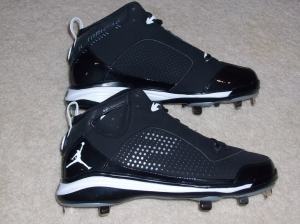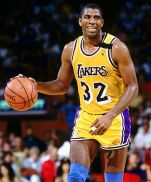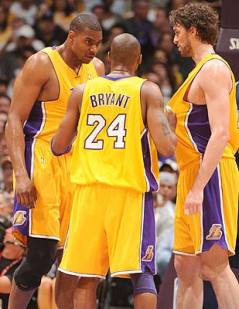So what do I do when I have nothing to write about?
I write about what I know best – the Lakers.
So I was thinking yesterday about the Lakers and how the team added Dwight Howard, Steve Nash, and Antawn Jamison this offseason.
When you think about this, and you wind back the clock three, four, five months and you really think about this, you wonder – How the f*** did this happen?
Lakers executive Jim Buss and general manager Mitch Kupchack just don’t get enough credit for saving a declining Lakers team/era.
It starts and ends with Andrew Bynum.
From the day he drafted him, Jim Buss supported Andrew Bynum like no one else did. He believed the young kid could blossom into a superstar, and the Lakers next franchise player.
In 2007, a struggling Lakers team was fighting to just make the playoffs. The deal was available – a package centered on Andrew Bynum for All-Star Jason Kidd. Many Lakers fans, and even Kobe Bryant, wanted the team’s management to pull the trigger on the deal. Jim Buss couldn’t do it. He couldn’t part ways with the 19-year-old center and his vast potential.
Then came the summer of chaos in 2007.
Kobe Bryant, frustrated with the Lakers front office for not making the Kidd deal, requested to be traded. He then trashed Bynum in a viral video that went public.
The Lakers and Minnesota Timberwolves began talking about trading Andrew Bynum and Lamar Odom for Kevin Garnett, but the T-Wolves wanted more.
With their franchise in disarray and their superstar player unsatisfied, it would have been easy for Kupchack and Buss to cave.
They didn’t. They held firm, and did so again, with the Jason Kidd offer remaining on the table. So the Lakers moved on from the summer without making any significant moves.
In 2008, Bynum started showing the talent that Buss always believed he had. But when Bynum went down with a knee injury, Kupchack made the Gasol trade and the Lakers went on to make three NBA Finals and win two championships.
Eventually the team’s championship window closed, and Buss and Kupchack returned to work.
In February 2011, the Carmelo Anthony sweepstakes were on. The offer was on the table – Andrew Bynum for Carmelo Anthony, with other minor players involved.
Anthony, an impending free agent, was willing to sign an extension with the Lakers. Bynum was coming off two knee surgeries in the last three season, and concerns that he was “injury-prone” were rampant at the time. Also, the team had a better record without him, 18-7, than with him, 18-9, that season.
The Lakers front office didn’t budge, in large part because Jim Buss strong support of Bynum.
Months later, after the team was coming off an embarrassing sweep to the Dallas Mavericks, the debate raged – should the Lakers give their core another chance or should they make a major move?
In December 2011, Jim Buss and Mitch Kupchack decided on the latter and traded for Chris Paul in a deal involving Pau Gasol and Lamar Odom, leaving the Lakers.

So David Stern allows the heavily lopsided Gasol trade, rejects the fair CP3 trade, and allows the lopsided Dwight trade?
What happened next was out of their control – David Stern rejecting the trade. Reigning Sixth Man of the Year, Lamar Odom, then asked to be traded, and Mitch Kupchack granted his wish.
Lakers fans everywhere were upset that Kupchack actually traded Odom, and more importantly got “nothing” in return for him. Even Bryant said he didn’t like the move.
They didn’t get “nothing” though. They received a first round pick and a $8.9 million trade exception, which would come in handy later.
After another second round exit in the 2012 playoffs, the Lakers definitely needed help. With Gasol’s consecutive second-round disappearing acts, he was the player most likely to be traded. So the trade offers came in – Kevin Martin and Luis Scola from Houston, Josh Smith from Atlanta, and other potential draft day trades.
The Lakers were a desparate team, but Kupchack and Buss were a patient duo. They wanted the right move, not just any move to please a frustrated fan base.
That patience paid dividends as the Lakers completed a sign-and-trade for two-time MVP Steve Nash in July, a move only possible with the Odom trade exception.
Then a month later, Jim Buss finally gave up Andrew Bynum, and Mitch Kupchack delivered the Dwight Howard trade.
Buss waited on Bynum as he developed from a 17-year-old project into the NBA’s second best center and then traded him for the league’s best center. Buss, the rich kid who supposedly lived off his father’s reputation, showed that he’s more than capable of managing the franchise.
To most Lakers fans, Buss and Kupchack will be remembered as the duo who brought Steve Nash and Dwight Howard to LA.
Instead though they should be remembered for all the moves they didn’t make.
Imagine the Lakers having Jason Kidd now? Or Kevin Garnett? Or even Carmelo?
Or they could have Steve Nash AND Dwight Howard now?
And that’s why every Lakers fan should send Jim Buss and Mitch Kupchack a card plus chocolates this Christmas.





















